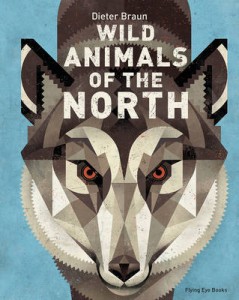 Wild Animals of the North
Wild Animals of the North
Dieter Braun, translated by Jen Calleja
(Flying Eye Books)
It is great to see translated books finally accepted in Carnegie and Greenaway lists, which allows for this beautiful exploration of the fauna in the Northern Hemisphere by German illustrator Dieter Braun to be included this year. This is the first in the series and has the feel of an illustrated encyclopedia, with a tremendous eighty species covered, split in three regions (North America, Europe and Asia) and narrative information including both common and scientific names. However, this is not an encyclopedia while facts are present, they are sparse and not every species has a paragraph devoted to it; rather it is a book to enjoy rather than to study from. The artwork really is the star of this tome, with often full-bleed portraits and vibrant colours which are emphasised by the use of uncoated paper. Very much like Paul Thurlby’s books for children, this is a treat for fans of graphic design and illustration.
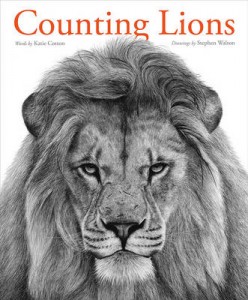 Counting Lions
Counting Lions
Stephen Walton (artwork) & Katie Cotton (text)
(Frances Lincoln Children’s Books)
This large format picturebook doubles a simple counting book and a polished manifesto for the protection of endangered animals. Each double-spread is dedicated to an animal, with a breathtaking portrait and facts about the species which can be found in a simple yet poetic text.
Walton’s use of charcoal on a white backdrop encourages readers to study each majestic creature up close and personal. The illustrations really are incredible, and many readers will have to look twice before realizing they are drawings rather than black and white photographs. The last two double-spreads goes back to each species emphasising the reasons why they are endangered. The book concludes on a second portrait of the lion, his face mostly hidden but his sadness and imploring radiating from his stance. Counting Lions is a stunning book which can be accessed on many levels, which makes it a wonderful read across ages.
 The Great Fire of London
The Great Fire of London
James Weston Lewis (artwork) & Emma Adams (text)
(Wren & Rook)
Stylish and intricate, the artwork in The Great Fire of London is the perfect companion to the accessible text depicting a pivotal event in British history. The limited palette of blues and oranges is effective at creating the right atmosphere of heat and smoke while highlighting what is burning and what is not. The huge iridescent flames filling and licking the endpapers are replicated in a full-spread as the fire finally takes over London and convey the speed of its assault dramatically. The use of perspective and positioning also helps readers engage the reader, giving him an idea of London at the time. I particularly love how the reader is watching from inside the bread oven of the Pudding Lane bakery, seeing things from the fire’s point of view.
This book illustrates perfectly how much of the information can be conveyed through the artwork in a non-fiction book, deepening the understanding of the causes and consequences of the Great Fire of London.
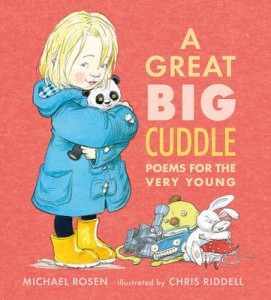 A Great Big Cuddle
A Great Big Cuddle
Chris Riddell (artwork) & Michael Rosen
(Walker Books)
There is always something so comforting about Riddell’s artwork for the very young; his characters are almost squishy, the baddies verging on the threatening but not quite, his colours both bright and soothing. He is brilliant at capturing little people’s expressions, and when teamed with Rosen’s crazy verse and astute observations of toddlers and preschoolers’ comportment, readers find themselves presented with a joyous celebration of early childhood. The large format, full-bleed illustrations and clever positioning of the text emphasise the playful nature of the book. It is a gentle, exuberant first introduction to poetry and a touching snapshot of a very magical time in childhood.
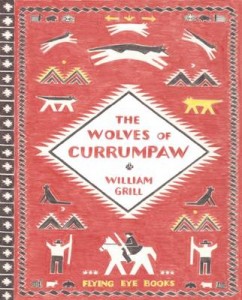 The Wolves of Currumpaw
The Wolves of Currumpaw
William Grill
(Flying Eye Books)
This title transports us to nineteenth century New Mexico where we follow hunter Seton on a mission to trap the infamous wolf pack leader, Lobo. Though based on a short story by Ernest Thompson Seton from his 1898 anthology “Wild Animals I Have Known”, The Wolves of Currumpaw is based on a true story, and the study and portrayal of America at that time offers a wealth of information also, not only in terms of history but also in terms of conservation.
Grill’s style is unique; his use of pencil conveys beautifully how harrowing the tale is. The palette he has chosen is reminiscent of many Native American art and textiles, and I cannot help but see hints of Lowry in his work, depending on the perspective of the spreads. This is most definitely a picturebook for older readers; the text is long, and despite the use of pencil, the artwork is incredibly complex at times. The alternating use of full spreads, small vignettes and sequential panels require a fairly trained eye and a lot of time spent on the illustrations. This is not surprising, considering this is originally an adult short story and the rather complex subject. One example of this are the introductory pages of the Old West, and the treatment of Native Americans portrayed in the vignettes. This is a fascinating tale and an accomplished visual historical, literary and zoological study.
—
source: review copies from publishers


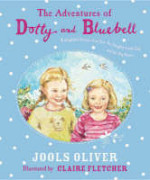


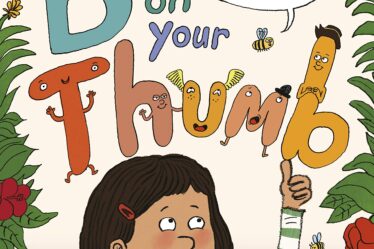
The Wolves of Currumpaw made me cry!
Yes, it is very evocative isn’t it? Will Grill is such a talented artist.